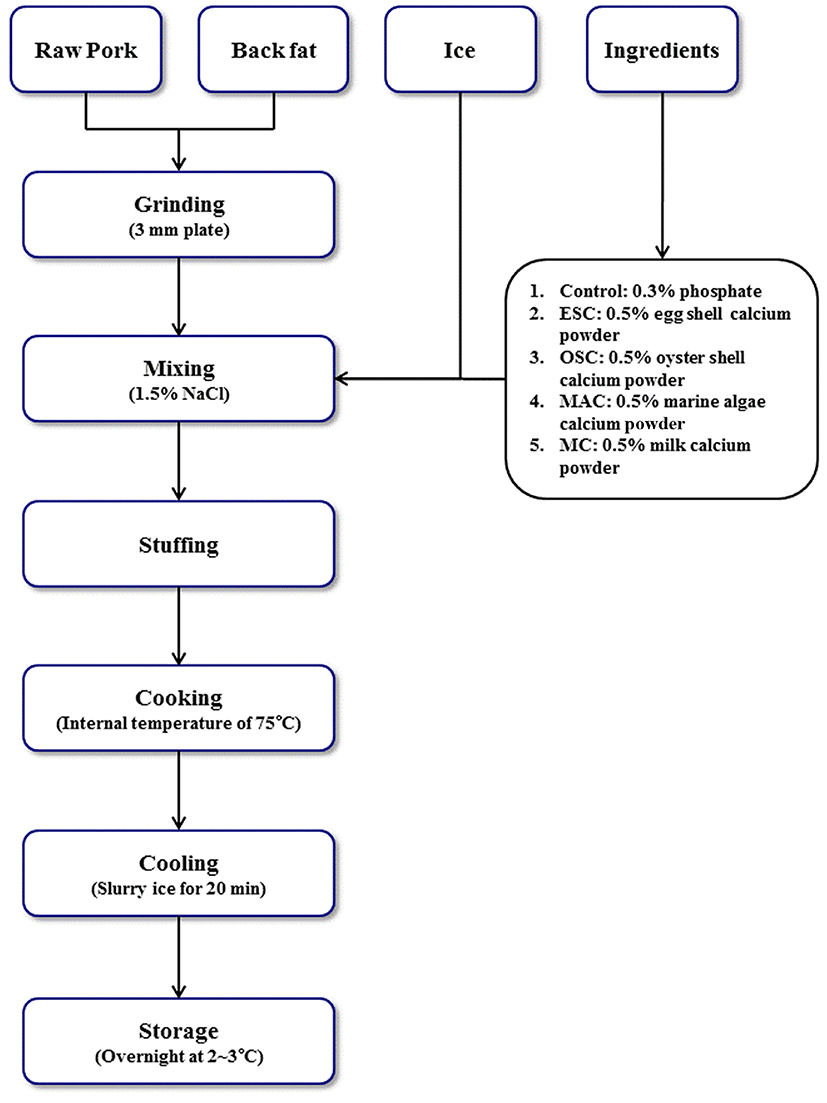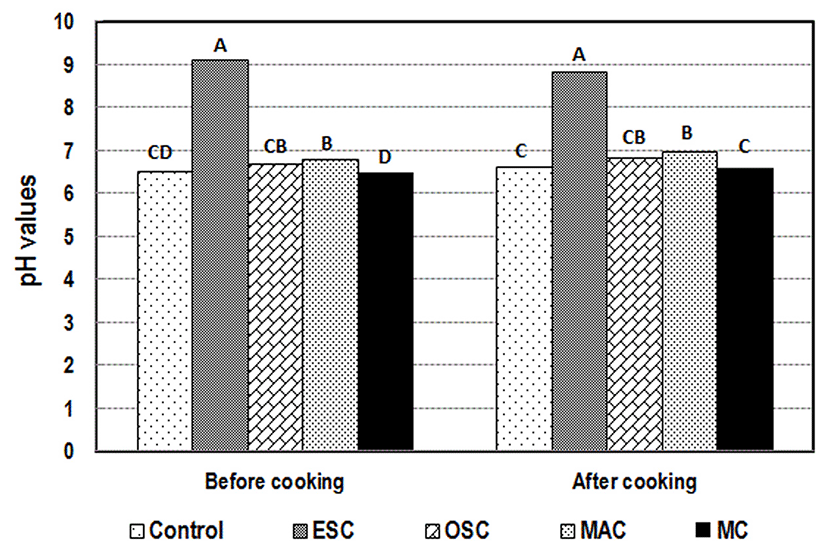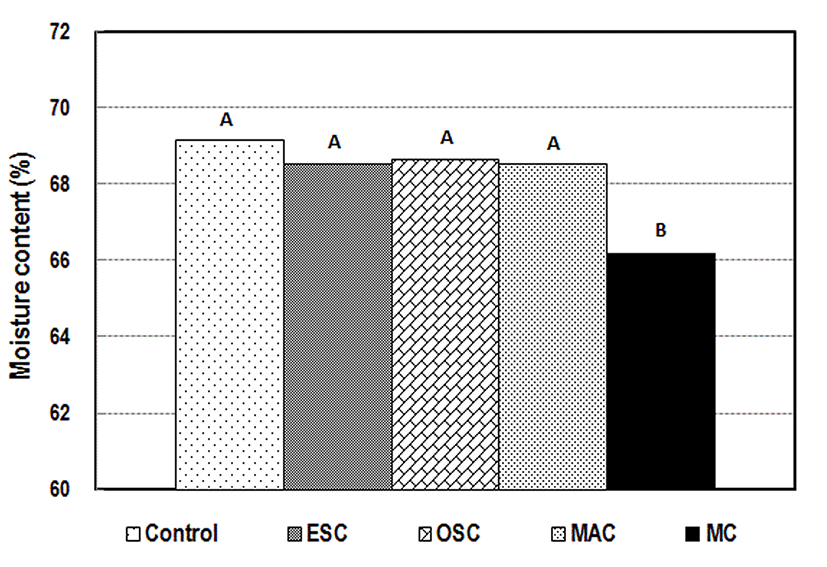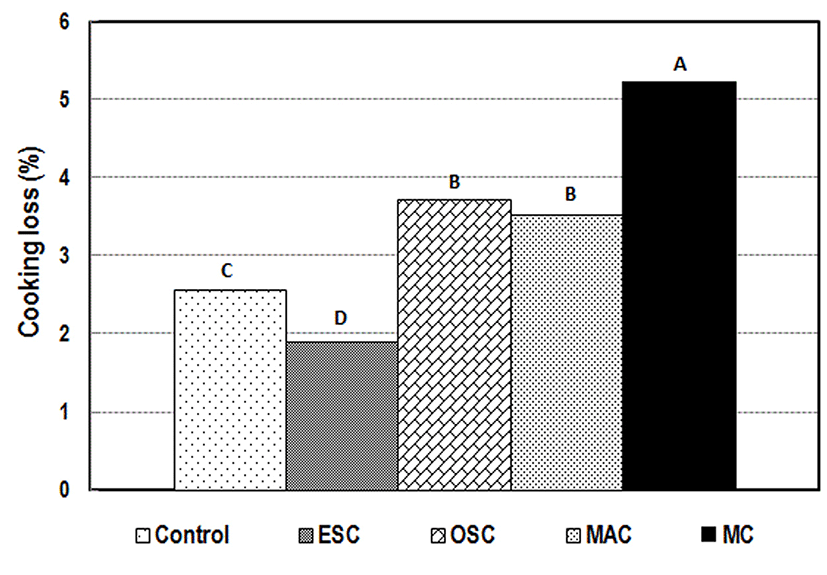Introduction
Phosphates are widely used as food additives as they contribute to the processing properties and functional characteristics of meat and poultry products. They are used in meat products to retain water holding capacity, inhibit lipid oxidation, reduce cooking loss, maintain color, and improve freeze-thaw stability (Long et al., 2011; Sebranek, 2015). Most importantly, phosphates can improve the ability of water retention and textural properties of meat products (Long et al., 2011; Sebranek, 2015; Xiong, 2005). When phosphates are used in cooked sausages and hams, their water holding capacity can be improved by increasing the pH. Furthermore, the addition of phosphates along with salts to meat products has been known to increase the ionic strength, which can improve protein functionality and bind moisture to the meat proteins, thus reducing weight loss during cooking and storage loss (Long et al., 2011; McKee and Alvarado, 2004; Petracci et al., 2013, Sebranek, 2015, Sindelar, 2015). Although the maximum permitted level of phosphate in the final processed meat and poultry products is 0.5% (USDA-FSIS, 2015), it is typically used at lower levels (0.3-0.4%) in the meat industry (Sebranek, 2009).
In response to the recent increase in consumer interest in processed foods with reduced synthetic additives, natural replacers for chemical synthetic materials are gaining attention. Because phosphates used in meat products are chemically synthesized additives, meat processors are searching for new and better replacers (Jeong, 2016; Sindelar, 2015). Many researchers and meat processors have had difficulty in discovering synthetic phosphate replacers, because the new substitute must maintain the inherent functional properties of phosphates at a reasonable cost of the final product (Sindelar, 2015). Nevertheless, the efforts for finding new phosphate replacers have continued, due to reports suggesting that excessive consumption of synthetic phosphate in processed foods could inhibit calcium absorption and bone formation (Virpi et al., 2006). Thus, to eliminate or reduce the use of synthetic phosphate in meat products, current efforts have focused on replacers derived from natural materials (Choi et al., 2014; Chun et al., 1999; Hooshmand and Arjmandi, 2009; Jarvis et al., 2012; Jarvis et al., 2015; Lee et al., 2011; Park et al., 2008). Park et al. (2008) compared the effects of guar gum, κ-carrageenan, alginic acid, and chitosan as replacers for inorganic polyphosphate in pork products. They found that guar gum and κ-carrageenan to be suitable replacers. Furthermore, Choi et al. (2014) recently investigated the effects of oyster shell calcium powder on the quality of restructured pork ham. They reported that a combination of oyster shell calcium and whey protein produced suitable quality characteristics as a phosphate replacer.
Natural calcium powders, which are widely used and distributed in the food industry, include oyster shell calcium (OSC), egg shell calcium (ESC), marine algae calcium (MAC), and whey calcium (milk calcium, MC). Each of these natural calcium powders has their own unique physico-chemical properties and sensory characteristics, as they differ in basic sources from raw materials and manufacturing methods. Because of these differences, they provide different processing properties when added to meat products. Therefore, this study aimed to determine the optimal and superior type of natural calcium powder for replacing synthetic phosphate in meat products. To achieve this, products treated with 0.5% each of OSC, ESC, MAC, or MC were compared with products treated with 0.3% synthetic phosphate.
Materials and Methods
The raw pork ham (M. biceps femoirs, M. semitendinosus, M. semimembranosus) used in this experiment was purchased from a local processor (Pukyung Pig Farmers Livestock Cooperatives, Korea) at 24-48 h postmortem. After removing subcutaneous and intermuscular fat and visible connective tissues from the fresh hams, the lean pork meat was cut in a square shape of approximately 4-5 cm, vacuum-packaged in nylon/PE film bags, and stored in a −18°C freezer until processing. Pork back fat was also prepared in the same manner. A phosphate blend (Polymix-CS, SDBNI Co. Ltd., Korea) was used as the synthetic phosphate. The natural calcium powders used in this study were ESC (Egg shell calcium 50, Essentron Co. Ltd., Korea), OSC (Oyster shell calcium, JK Biochem Co. Ltd., Korea), MAC (Marine algae calcium, TOF Co., Ltd., Korea), and MC (Milk calcium powder, TOF Co., Ltd., Korea). The samples were prepared by purchasing commercially available products. The formulation of the pork meat products with the various natural calcium powders is shown in Table 1.
1)Control: 0.3% phosphate blend, ESC: 0.5% egg shell calcium powder, OSC: 0.5% oyster shell calcium powder, MAC: 0.5% marine algae calcium powder, MC: 0.5% milk calcium powder.
The frozen pork ham and back fat were held at 2-3°C for 24-36 h before processing them into meat products. The thawed raw materials were ground in a chopper (TC-22 Elegant plus, Tre Spade, Italy) equipped with an 8-mm plate and then with a 3-mm plate. The controls were prepared by mixing ground pork meat and back fat with ice water, salt (1.5%), and phosphate blend (0.3%) in a mixer (KitchenAid 5K5SS, Whirlpool Corp., USA) for 5 min (Fig. 1). For the natural calcium treatment, the samples were prepared by adding ESC, OSC, MAC, or MC, respectively, with ice water and salt (1.5%) to the ground pork meats and back fat. Each batch from the control and natural calcium treatments was stuffed into conical tubes (approximately 50 g each) using a stuffer (MOD.5/V Deluxe, Tre Spade, Italy). The stuffed tubes were centrifuged at 2000 × g for 10 min in a centrifuge (FELTA5, Hanil Scientific Inc., Korea) to remove the air pockets. The tubes were then transferred into a 90°C water bath (CB60L, Dong Won Scientific System, Korea) and cooked until the internal temperature reached 75°C. The changes in temperature were monitored by inserting a K-type thermocouple attached to a digital thermometer (TES-1384, Ketech Scientific Instrument Co., Ltd., Taiwan) into the center of the extra stuffed samples. After cooking, the samples were immediately cooled on ice slurry for 20 min and cooled at 2-3°C overnight, prior to measuring the cooking loss. The samples were further stored for 2 d at 2-3°C until the analysis. The experiments were replicated thrice.

From each treatment, 5 g sample was collected before and after cooking, and then homogenized with 20 mL of distilled water for 1 min in a homogenizer (DI 25 basic, IKA®-Werke GmbH & Co. KG, Germany). Measurements were obtained using a glass electrode pH meter (Fisher Scientific Accumet AB150, Thermo Fisher Scientific, Inc., Singapore).
For cooked products, moisture content was measured using the drying method (AOAC, 2007). After drying the samples in a 105°C dry oven (CB60L, Dongwon Scientific System, Korea) for 12 h, the difference between the weight of each sample before and after drying was calculated.
As previously described, the weight of the each sample in the conical tubes was measured prior to cooking and then again after cooking and cooling to determine the cooking loss. The difference between the weights before and after cooking was calculated as shown below:
On the freshly cut surface of the cooked samples, a colorimeter (Chroma Meter CR-400, illuminant C; Konica Minolta Sensing Inc., Japan) was used to measure the CIE L* values (indicating lightness), CIE a* values (indicating redness), and CIE b* values (indicating yellowness). Two slices from each cooked sample were cut in half, parallel to the longitudinal axis, and three CIE L*a*b* readings per slice were taken immediately following cutting. The colorimeter was standardized against a white calibration plate (CIE L* +94.90, a* −0.39, and b* +3.88).
After cutting the samples at a width of 2.5 cm perpendicular to the longitudinal axis, the hardness, springiness, cohesiveness, gumminess, and chewiness of the samples were measured using a texture analyzer (TA-XT2i, Stable Micro System, UK) equipped with a 50-mm diameter aluminum cylinder (Bourne, 1978). The cross-head speed for measurement was 5 mm/s.
All experiments were replicated thrice. The results of the experiments were statistically processed using the generalized linear model (GLM) procedure of the SAS package program (SAS, 2012). When the analysis of variance showed a significant difference between the means of different samples, the significance of the differences were further analyzed using the Duncan's multiple range test (p<0.05).
Results and Discussions
Typically, the phosphate used in processed meats is alkaline. This alkaline phosphate is used as a means to improve water retention by increasing the pH and ionic strength of meat mixtures (Sebranek, 2009). Thus, among the various desirable properties for an ideal replacer of synthetic phosphate in meat products, the pH is an important factor that determines the water holding capacity of meat products. The pH values of the ground pork meat products added with various natural calcium powders before and after cooking are shown in Fig. 2. The samples treated with ESC had the highest pH value (pH 9.09; p<0.05) before cooking, suggesting that the addition of ESC powder affected the pH of the product (Cho and Jeong, 2016). Although the pH of samples treated with MAC (pH 6.79) was subsequently higher (p<0.05) than that of the controls (pH 6.50), the pH of the samples treated with OSC and MC were not significantly different (p>0.05) from that of the controls. Although the pH of the samples treated with ESC was found to decrease upon cooking, they had the highest pH (pH 8.82; p<0.05) among all the samples tested in this study. The pH of the samples treated with MAC (pH 6.96) was eventually higher than that of the controls (p<0.05). In contrast, the pH of the samples treated with OSC and MC was not significantly different from that of the control samples (p>0.05). The samples treated with ESC showed the highest pH values in our study, likely because the ESC powder developed into a strong alkali due to the rapid pH change, as it was ionized (Shin and Kim, 1997). These results were consistent with those of Daengprok et al. (2002), who reported that the addition of eggshell calcium lactate significantly increased the pH of fermented pork sausages. Park (2011) investigated the processing characteristics of emulsion-type sausages after adding 0.5% whey protein and natural oyster shell calcium as a phosphate replacer, reporting that the pH of the samples treated with 0.3% or more oyster shell calcium was significantly higher than that of the controls with 0.3% phosphate.

The moisture content in the ground pork products was measured as an indicator of the water holding capacity, and the results are shown in Fig. 3. Compared to the control samples (69.16%), the samples treated with ESC (68.53%), OSC (68.65%), and MAC (68.55%) had similar moisture contents (p>0.05). The samples treated with MC showed the lowest moisture content (66.17%) (p<0.05). Thus, the addition of ESC, OSC, and MAC to ground pork meat products had similar effects on water retention as the addition of synthetic phosphate. Other studies that investigated phosphate substitution effects in meat products have reported that the moisture content of the products varied based on the type and amount of ingredients used, as well as the type of meat products (Casco et al., 2013; Choi et al., 2014; Cofrades et al, 2008; Lee et al., 2011). Choi et al. (2014) investigated the moisture content of restructured pork hams prepared by mixing oyster shell calcium and whey proteins. They reported that, when treated with increasing amount of OSC, the restructured pork hams showed higher moisture content than pork hams treated only with phosphate. Casco et al. (2013) used SavorPhos, a commercially available citrus flour blend, to evaluate the phosphate substitution effects in chicken marinade; they reported no difference in moisture content between samples treated with SavorPhos and those treated with phosphate blend in two types of marinades (water and oil-water), which was consistent with the findings in this study.

This study aimed to improve the water holding capacity and binding capacity of meat products by substituting synthetic phosphate with various natural calcium powders. Cooking loss was therefore used as a measure to indirectly evaluate these properties. As shown in Fig. 4, the cooking loss in the samples treated with ESC was the lowest (p<0.05) among all the samples. When compared to previous researches for replacers to phosphate in meat products (Casco et al., 2013; Kim and Chin, 2010; Ruusunen et al., 2003), the amounts of cooking loss in this study were considerably less. It appears that added egg shell calcium powder is positively effective at decreasing cooking loss of pork products without phosphate. Thus, ESC was evaluated as a candidate phosphate replacer that provided superior water retention ability to meat products and that enables the manufacture of products with lower cooking loss than the products added with synthetic phosphate. However, products treated with all other calcium powders showed higher cooking loss than the controls (p<0.05), with those treated with MC showing the highest cooking loss (p<0.05). These results were similar to those of the pH analysis described in this experiment (Fig. 2), suggesting that the cooking loss in the meat samples was reduced due to the relatively higher pH values (Long et al., 2011; Sindelar, 2015), which was due to the addition of ESC. In contrast, a recent study on the substitution of phosphate in meat products by Jarvis et al. (2012) showed that the addition of 0.22% dried plum blend and 1.1% and 2.2% plum concentrate to chicken breast marinade caused no significant difference in cooking loss, compared to the control samples with phosphate. Lee et al. (2011) used oyster shell calcium and whey protein on emulsion-type meat products, showing that the addition of 0.3% oyster shell calcium resulted in products with cooking loss similar to that of products added with phosphate alone. They had also reported that such addition could significantly improve the cooking loss, compared to products without phosphate.

Table 2 shows the CIE color values of ground pork meat products added with various natural calcium powders. The CIE L* values (indicating lightness) were highest in the samples treated with OSC and MC, among all the studied samples (p<0.05). The CIE L* value of the samples treated with MAC was not significantly different from that of the controls (p>0.05). In contrast, the samples treated with ESC were found to have significantly lower CIE L* values than the controls (p<0.05). Cho and Jeong (2016) investigated the combined effects of ESC and OSC on meat products. They reported that the L* values tended to decrease as the amount of ESC added increased, which was consistent with the results of this study. The CIE a* value (indicating redness) was higher in samples treated with ESC than in the controls (p<0.05). These results were observed, likely due to the elevated pH caused by ESC treatment. At high pH values, lesser amount of myoglobin is likely to be denatured during cooking, which may contribute to increase of red color (Trout, 1989). However, CIE a* values of samples treated with the other natural calcium powders were not different from those of the control samples (p>0.05). The CIE b* value (indicating yellowness) was found to be highest (p<0.05) in the samples treated with ESC, whereas those treated with the other calcium powders showed no significant difference from the control samples (p>0.05). Similar results were obtained by Park et al. (2008), who reported that pork meat products manufactured after replacing phosphate with functional carbohydrates such as carrageenan, alginic acid, guar gum, and chitosan showed no significant difference in their b* values, compared to products with phosphate. Lee et al. (2011) also reported that there was no difference between the a* values of sausages added with OSC and those added with phosphate only. These results were also consistent with the results of this study. However, Lee et al. (2011) also reported that b* values were significantly higher in samples treated with phosphate alone than in those added with OSC, which was not consistent with the results of this study.
1)Control: 0.3% phosphate blend, ESC: 0.5% egg shell calcium powder, OSC: 0.5% oyster shell calcium powder, MAC: 0.5% marine algae calcium powder, MC: 0.5% milk calcium powder.
All values are presented as means±standard error of triplicates.
A-CMeans within the same row with different superscript letters are significantly different (p<0.05).
Table 3 shows the results of the texture profile analysis of cooked ground pork products added with various natural calcium powders. Hardness, gumminess, and chewiness were higher (p<0.05) in the control samples treated with synthetic phosphate than in samples treated with the natural calcium powders. However, no significant differences (p>0.05) were observed between the samples treated with the different natural calcium powders. Cáceres et al. (2006) reported that the addition of calcium salts (calcium lactate, calcium gluconate, and calcium citrate) caused the hardening of sausages, compared to products not treated with additives. Generally, hardness was highly correlated with moisture content of meat products, where the higher moisture contents the more tender (Casco et al., 2013; Nuñez de Gonzalez et al., 2008). As previously described, the moisture content in this study was similar between the control and the samples treated with ESC, OSC, or MAC. However, textural properties were observed to be lower in products added with natural calcium than in those added with phosphate. These results were likely because phosphate, when combined with NaCl, can improve the binding capacity by increasing the ionic strength and protein solubility (Sebranek, 2015; Sindelar, 2015), whereas the addition of natural calcium into ground pork products interferes with the protein-protein interactions or protein solubility in the meat system (Daengprok et al., 2002). In the present study, the results for gumminess and chewiness were similar to those for hardness, likely because hardness determines secondary parameters such as gumminess and chewiness (Bourne, 1978; Cáceres et al., 2006). No significant differences (p>0.05) were observed between the springiness of control samples and that of samples treated with natural calcium powders. The cohesiveness of the samples treated with ESC was not significantly different from that of the controls (p>0.05), while samples treated with OSC, MAC, and MC showed lower cohesiveness than the control samples (p<0.05).
1)Control: 0.3% phosphate blend, ESC: 0.5% egg shell calcium powder, OSC: 0.5% oyster shell calcium powder, MAC: 0.5% marine algae calcium powder, MC: 0.5% milk calcium powder.
All values are presented as means±standard error of triplicates.
A,BMeans within the same row with different superscript letters are significantly different (p<0.05).
Conclusions
In conclusion, ESC was the most suitable candidate for phosphate substitution, as it minimized the cooking loss, likely by increasing the pH of the product. Nevertheless, since the use of 0.5% ESC alone resulted in an extreme increase in pH, the amount of ESC added should be strictly regulated. Furthermore, when the texture of products treated with natural calcium powders and those treated with synthetic phosphate was compared, ESC and OSC were found to have a relative substitution effect. In contrast, the use of MC had the most negative effects on cooking loss and moisture retention. Therefore, the combined use of ESC and OSC to cooked pork products could contribute to functional properties as a complementary replacer for synthetic phosphate. Future studies should explore the effectiveness of the combination of ESC and OSC at different levels and ratios for producing phosphate-free meat products.













